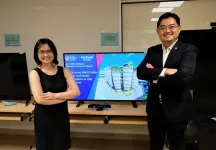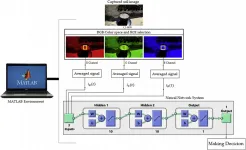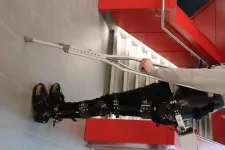(Press-News.org) A study by a research team from Nanyang Technological University, Singapore (NTU Singapore) and China's first digital-only bank WeBank has found that security, service quality and system quality are the most important factors for customers who use mobile banking.
Two in five respondents (40%) said that the security they felt while carrying out transactions on mobile applications was their most important consideration.
This was followed by the level of service quality (25%), which referred to whether the banking applications could fulfil users' needs, such as carrying out transactions and easy access to credit card services.
System quality, which considers the performance of the application, including compatibility with different mobile phones and loading speeds, came in a close third (24%).
The results of the study were published in the Journal of Retailing and Consumer Services, an academic publication by Elsevier, last December.
The researchers said their study which ranked factors that are important in determining customer loyalty would be useful to financial institutions who are looking at improving their mobile banking applications.
Already widely used in China prior to COVID-19, mobile banking applications have seen a sharp rise in uptake throughout Asia during the pandemic, as the touchless payment systems provided by most mobile banking applications have gained traction.
The NTU-WeBank team obtained their results after surveying 224 mobile banking users of a large bank in China in 2019. Over three-quarters of the respondents (79%) were frequent users of mobile banking, meaning that they used it at least once a week.
The researchers said that although the study was conducted in China, the results are applicable to other countries where mobile banking has a high level of adoption, such as Singapore, Thailand, and Vietnam.
Associate Professor Xu Hong, from NTU's School of Social Sciences who led the study, said: "It was already known that all these factors: security, service quality, system quality, and interface design had an impact on customers, and this study highlights implications for banks' strategies for retaining their mobile banking users, as well as exploring how to capture new customers."
Assistant Professor Yu Han, from NTU's School of Computer Science and Engineering, who co-led the research, said: "Our study has implications for banks' strategies for retaining their mobile banking users, as well as exploring how to capture new customers."
Assoc Prof Xu and Asst Prof Yu are part of the team at the Joint NTU-WeBank Research Centre on Fintech which initiated this study. The joint centre was launched in early 2019 with the aim of developing new technologies to support Banking 4.0, where banking can be personalised and done anytime, anywhere.
Mr Joe Chen, Executive Vice President of WeBank, said: "The findings are relevant to other banks who are increasingly rolling out more digital solutions, which include payment, lending, and wealth management applications. As mobile banking worldwide is becoming increasingly accepted as replacement for branch-based banking in many countries, it is important for banks to know the factors that affect and influence customer loyalty. In this regard, the Joint NTU-WeBank Research Centre will continue to generate research outcomes and innovations for the benefit of the Fintech industry."
NTU Senior Vice President (Research) Professor Lam Khin Yong, added: "The NTU-WeBank partnership is another example of the University's strong links with the private sector. It also shows our strong support for industry collaborations that accelerates the translation of research into innovation and commercial adoption. This study also serves as a good example of interdisciplinary research involving faculty from the social sciences and computer science, as it solves a very important issue in today's fintech industry."
A multi-pronged approach to build customer loyalty
The team's analysis of the results also showed that a mobile application's interface design had a strong and positive impact on respondents' evaluation of system and service quality.
This is despite it scoring relatively low compared to other factors surveyed in the study. For example, the team found that respondents tended to associate good interface design, such as smooth transitions between pages, with optimal system quality and high security.
The findings also outlined a larger correlation between several factors that were surveyed. For example, service and system quality and interface design were found to be important in sparking user loyalty, which the researchers defined as "the intention to continuously use the mobile banking product and recommend it to others."
After analysing the survey results, the team advised that mobile banking operators should focus on providing multi-level security features to increase the users' sense of security when using the applications.
Such features might include pop-up messages that alert users to the potential risks that could occur when using mobile banking services, as well as a well-documented policy statement from the financial institution.
Besides providing users assurance of their security while using the applications, Assoc Prof Xu added: "The level of service quality, which encompasses factors such as the levels of reliability, responsiveness, and empathy from bank staff, could enhance users' satisfaction and increase their usage of mobile banking services."
"By providing a stable and secure mobile banking system that boasts fast responses and efficient service, banks can encourage customers to continue using their mobile banking application, while ultimately strengthening user loyalty. The results can also help improve their overall mobile banking strategy and cater the functions of their apps to the needs of different age groups."
Next steps: overseas studies
To further their research on loyalty intention in mobile banking, the NTU-WeBank team is looking to conduct studies in other countries and regions to identify other determinants that could affect customer loyalty.
Assoc Prof Xu said the team will continue to leverage the computing platform which it has developed to collect and analyse user experience data for future studies.
"We believe the large-scale immersive studies we will conduct using our computing platform powered by social computing and social media technologies will be able to help banks gain more insights into customers' intentions," said Assoc Prof Xu.
INFORMATION:
Researchers at UniSA have developed a cost-effective new technique to monitor soil moisture using a standard digital camera and machine learning technology.
The United Nations predicts that by 2050 many areas of the planet may not have enough fresh water to meet the demands of agriculture if we continue our current patterns of use.
One solution to this global dilemma is the development of more efficient irrigation, central to which is precision monitoring of soil moisture, allowing sensors to guide 'smart' irrigation systems to ensure water is applied at the optimum time and rate.
Current methods for sensing soil moisture are problematic - buried sensors are susceptible to ...
Dr Daniel Montesinos is a Senior Research Fellow at the Australian Tropical Herbarium, at James Cook University in Cairns. He is studying weeds to better understand (among other things) how they might respond to climate change.
He said most invasive plants are characterised by their rapid pace when it comes to taking up nutrients, growing, and reproducing - and they're even faster in the regions they invade.
"New experiments comparing populations from distant regions show a clear trend for already-fast invasive plants to rapidly adapt even faster traits in their non-native regions," Dr Montesinos said.
This is further pronounced in the tropics and sub-tropics.
"Even though invasives' growth rates are already among the highest for plants, when they invade new territory ...
A new concept of on-demand drug delivery system has emerged in which the drugs are automatically released from in vivo medical devices simply by shining light on the skin.
A research team led by Professor Sei Kwang Hahn of the Department of Materials Science and Engineering and Professor Kilwon Cho of the Department of Chemical Engineering at POSTECH have together developed an on-demand drug delivery system (DDS) using an organic photovoltaic cell coated with upconversion nanoparticles. This newly developed DDS allows nanoparticles to convert skin-penetrating near-infrared (NIR) light into visible light so that drug release can be controlled in medical ...
An international team of researchers, affiliated with UNIST has unveiled a novel technology that could improve the learning ability of artificial neural networks (ANNs).
Professor Hongsik Jeong and his research team in the Department of Materials Science and Engineering at UNIST, in collaboration with researchers from Tsinghua University in China, proposed a new learning method to improve the learning ability of ANN chips by challenging its instability.
Artificial neural network chips are capable of mimicking the structural, functional and biological features of human neural networks, and thus have been considered the technology of the future. In this study, the research team demonstrated the effectiveness of the proposed learning method ...
A chromatin-regulating enzyme has been shown by in-depth interdisciplinary investigations to be a key driver of a common type of lung cancer. Drugs that target the enzyme could improve treatment and survival rates for this particular cancer.
"Squamous cell carcinoma represents nearly one third of all lung cancers in humans," says KAUST structural biologist Lukasz Jaremko, who led the research along with colleagues at Stanford University and The University of Texas MD Anderson Cancer Center, U.S. "Our joint structural and dynamics investigations, including enzymatic activity studies, genetic analyses, and mouse model and human cell results, ...
Basic, acidic, basic again: for pathogenic bacteria such as Salmonella, the human digestive tract is a sea change. So how do the bacteria manage to react to these changes? A team of researchers from the Max Planck Institute for Terrestrial Microbiology in Marburg led by Andreas Diepold has now provided a possible explanation: pathogenic bacteria can change components of their injection apparatus on the fly - like changing the tires on a moving car - to enable a rapid response.
Some of the best-known human pathogens - from the plague bacterium Yersinia pestis to the diarrhea pathogen Salmonella - use a tiny hypodermic needle to inject disease-causing ...
Despite pandemic-driven restrictions on movement, there were over 12,000 accidents in Madrid in 2020, leading to 31 fatalities. In Barcelona, there were more than 5,700 collisions, causing 14 deaths. Pedestrian and vehicle safety is a priority, which is why a research project at the Universitat Oberta de Catalunya (UOC) is harnessing artificial intelligence (AI) to make decisions that will make cities safer. The researchers have looked into the correlation between the complexity of certain urban areas and the likelihood of an accident occurring there.
According to the researchers, the data they have gathered can be used to train neural networks to detect probable ...
Last December, the Parliament of Catalonia unanimously approved the incorporation into its legislation of second-order violence against those who give their support to victims of violence against women. A recent study compiles testimonies of victims, and analyses this form of intimidation
To tackle violence against women, it is essential for victims to have the support of those surrounding them and to prevent them from being isolated. But what happens if the people around them are not protected? The work of Jose Ramón Flecha García, founder of the Community of Research on Excellence for All (CREA), and various academic teams, has led to the approval in the Catalan parliament of the first legislation on the Second Order of Sexual Harassment (SOSH).
The following point ...
Robotics researchers are developing exoskeletons and prosthetic legs capable of thinking and moving on their own using sophisticated artificial intelligence (AI) technology.
The system combines computer vision and deep-learning AI to mimic how able-bodied people walk by seeing their surroundings and adjusting their movements.
"We're giving robotic legs vision so they can control themselves," said Brokoslaw Laschowski, a PhD candidate in systems design engineering who leads a University of Waterloo research project called ExoNet.
Exoskeletons and prosthetic devices operated by motors already exist, but users must manually ...
In 2016, a collaborative group of research and education specialists received funding from the National Science Foundation for the project 'Building a Comprehensive Evolutionary History of Flagellate Plants' -- also known as 'Genealogy of Flagellate Plants' (GoFlag). Members of the team have the ambitious goal of reconstructing the 470-million-year history of one of the most diverse groups of land plants on the planet.
The first of several forthcoming publications from the project was published in a recent issue of Applications in Plant Sciences. In their inaugural article, the researchers report on the successful development of 451 nuclear target enrichment probes, which correspond to short, variable loci.
By creating a standard ...







